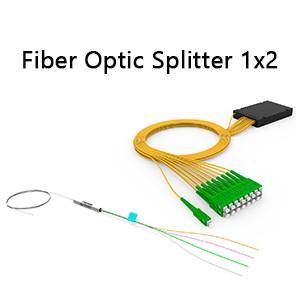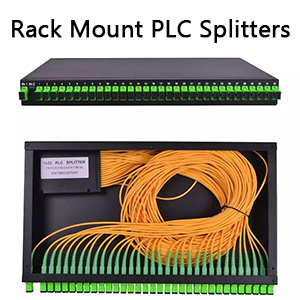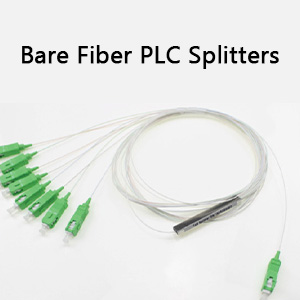In order to minimize network risks and meet network monitoring needs, six DWDM transmission network solutions are listed here, namely OLP, OPD, OPM, RNP, OCM, and full protection. The following example DWDM solution uses a 40CH DWDM Mux/Demux by default, equipped with a 10G DWDM 80km transceiver, and a G.652 fiber grade. In a point-to-point network, the 80km distance design takes into account a fiber attenuation of 0.25dB per kilometer. In a three-point ring network, the distance between each two sites is 40 kilometers.
01.Optical Line Protection (OLP)
OLP is a device used to protect the transmission line of an optical network. It supports optical power monitoring and automatic switching of optical lines. In an optical communication network, OLP continuously monitors the optical power of the main optical fiber and the backup optical fiber in real time.
When the current optical power of the optical fiber drops below the preset switching threshold, an alarm is triggered and it automatically switches to the backup optical fiber within 15 milliseconds to protect the optical transmission system line. It should be noted that the lengths of the main link and the backup link must be similar to ensure optimal performance.
In addition, there are different types of OLP devices to choose from, the most commonly used are OLP 1:1 and OLP 1+1. These changes provide flexibility in designing and implementing optical network protection strategies.
02.Optical Power Detection (OPD)
OPD is very accurate and is well suited for monitoring optical systems with accuracy and wide capabilities. It measures the loss of optical fibers, cables, and passive devices to help maintain communication systems.
Like an optical power meter, OPD mainly uses 1310nm/1550nm light for real-time fiber monitoring and rapid identification of faults. This enhances the stability of DWDM, maintains quality, and reduces user losses. However, OPD cannot distinguish between faults in the fiber and equipment.
In this case, OTDR can evaluate the fault in the intermediate link and analyze the signal transmission to detect problems such as fiber breaks. If the OTDR test shows no abnormalities, the equipment may be the source of the fault.
03.Optical Performance Monitoring (OPM)
In DWDM networks, OPMs are essential for continuously monitoring the quality of data channels by evaluating optical characteristics in real time. They ensure accurate switching in reconfigurable optical add/drop multiplexers, dynamically adjust optical amplifier gain, and issue system alarms when any deviation occurs in the optical channel.
However, long-haul DWDM transmission faces challenges, especially signal attenuation in long fiber cables. In order to maintain top-level optical signal and data integrity, it is critical to deploy OPMs strategically along the route. It is important to note that the current application of OPMs is limited to the C-band spectrum.
It is important to note that although the current application of optical power meters (OPMs) is limited to the C-band spectrum, OSA can monitor other spectral bands.
04.Optical Channel Monitoring (OCM)
OCM is critical in optical network systems, ensuring real-time monitoring of wavelength and power of optical signals for smooth and efficient network operation. With the ability to support multiple channels, OCM provides continuous monitoring to ensure signal quality, stability and strength to promote reliable network transmission.
In addition, OCM facilitates remote monitoring of DWDM wavelengths on optical fibers, improving monitoring efficiency and effectiveness. Fiber-life latest release, the D7000 Series OCM, has improved monitoring capabilities by enabling monitoring of individual channels. Utilizing the built-in optical switch (OSW), it achieves fast channel switching, facilitating effective monitoring of multiple channels in a short period of time.
This advancement greatly improves monitoring efficiency and accuracy, ensuring optimal network performance. In addition, the D7000 Series OCM can be seamlessly connected to the 40-channel MUX/DEMUX monitoring port, detecting wavelengths in the range of 1528~1568nm, further expanding its monitoring capabilities and compatibility.

05.Ring Network Protection (RNP)
Integrating DWDM protection into the shared optical channel architecture in a ring network setting provides an economical and secure solution. For example, in a three-point ring network, services can be seamlessly switched between different sites to address faults such as fiber breaks. This specialized protection system provides greater robustness compared to traditional methods. By using a second-layer ring protection, it effectively minimizes service interruptions caused by internal fiber breaks, ensuring continuous business operations.
If a fiber break occurs between two sites, data can be redirected to the destination, allowing uninterrupted business operations. The architecture consists of two or more devices, using a second-layer protocol to smoothly manage the failover of protected traffic to avoid interruptions. In addition, it also includes a data ring to further reduce service interruptions and built-in redundancy to effectively prevent downtime.
06.Full protection
Adding another identical configuration to the solution may not seem reasonable, especially with regard to DWDM systems. However, if the budget allows for additional fiber, this is very applicable. The goal is to ensure normal operation by quickly switching the broken link to the additional allocated capacity within a certain time frame.
It is feasible to use redundant parts of the network to provide additional capacity in the event of a failure or failure, especially in point-to-point DWDM solutions. This is crucial because equipment, fiber or node failures are not uncommon and can sometimes result in significant revenue losses.
Conclusion
In summary, as networks shift toward increased automation and less reliance on manual processes, it is critical to implement strong safeguards to detect and mitigate security breaches. Fiber-life offers dedicated DWDM solutions, including OLP, OPM, OCM, and OPD, each of which provides many benefits, including efficient DWDM troubleshooting capabilities. These solutions not only minimize network errors, but also ensure more reliable connectivity to meet future regulatory requirements.
Considering potential future technology trends, it is clear that the security of DWDM equipment will remain an essential component of network infrastructure. Therefore, emphasizing the importance of security measures in DWDM deployments is a proactive approach to address evolving security challenges and maintain network integrity.










